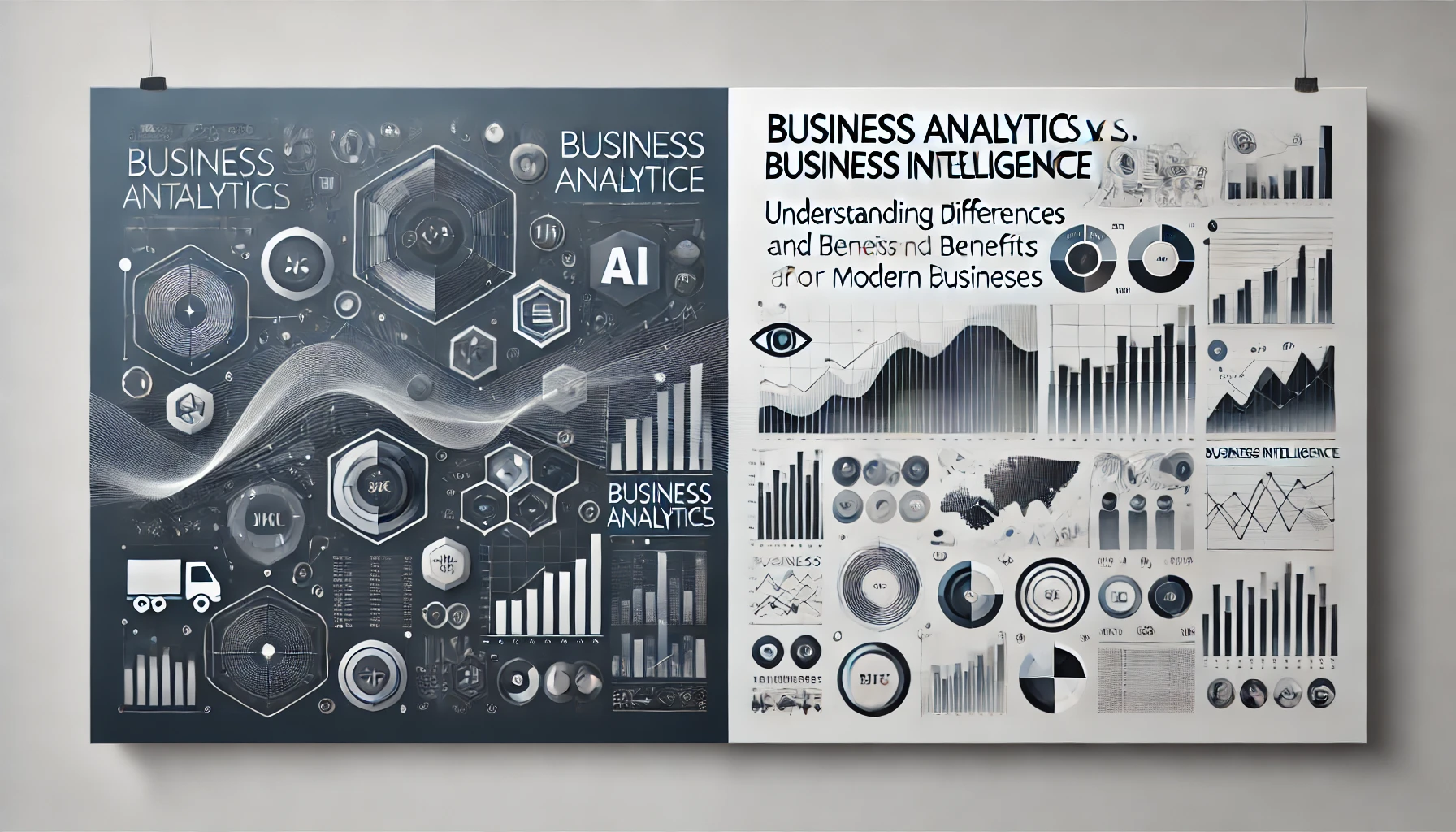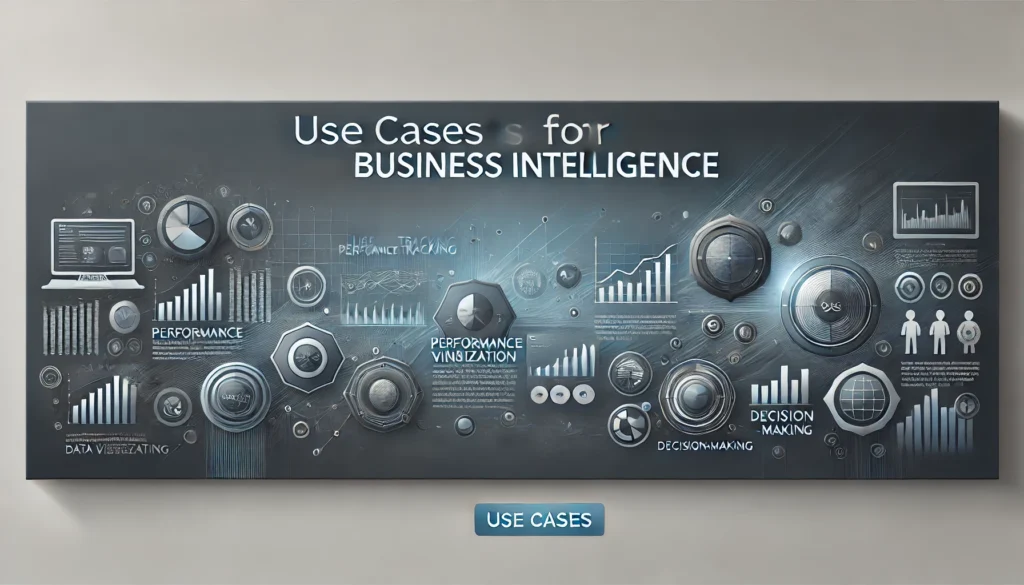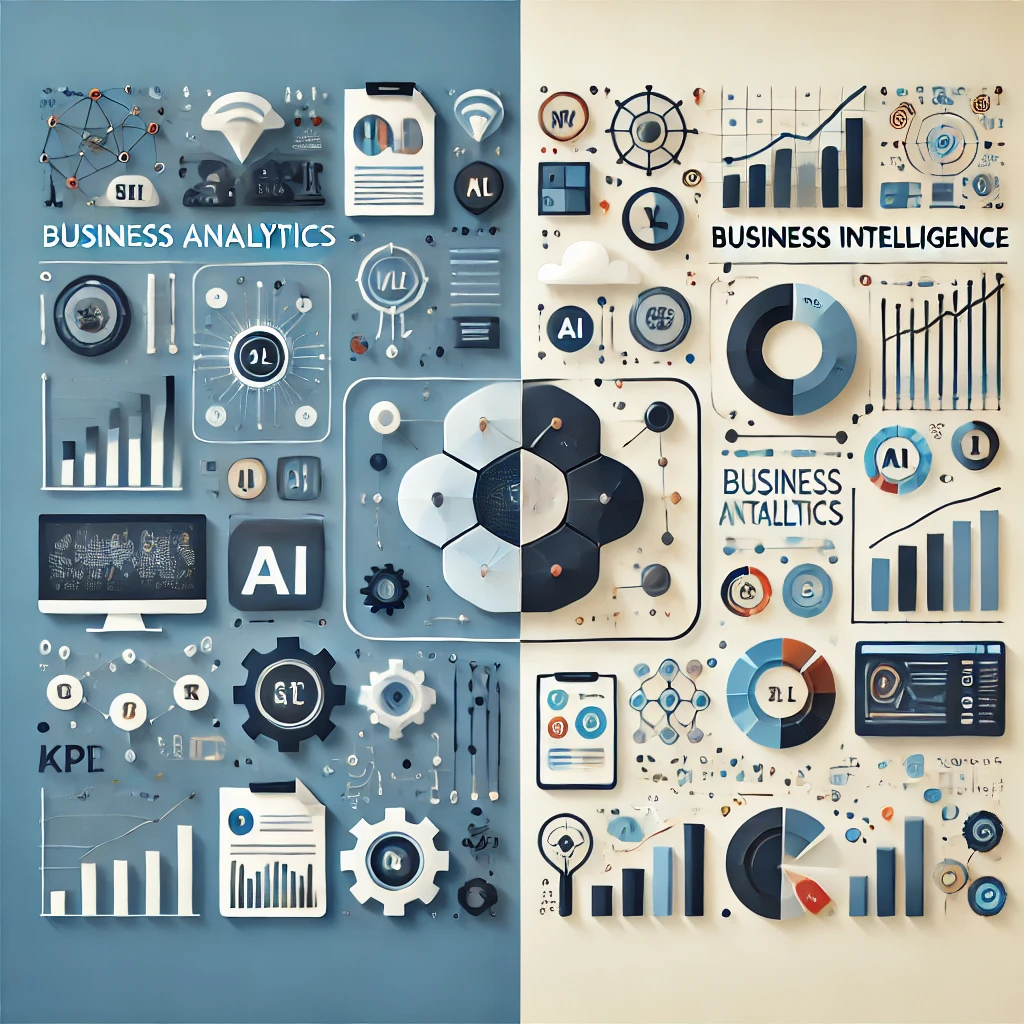Business Analytics vs. Business Intelligence: Understanding Key Differences and Benefits for Modern Businesses
In today’s data-driven world, businesses have access to an overwhelming amount of information. To leverage this data effectively, organizations often utilize two essential tools: Business Analytics (BA) and Business Intelligence (BI).
While these terms are frequently used interchangeably, they represent distinct processes and serve different purposes. This article will delve into the fundamental differences between Business Analytics and Business Intelligence, explore their respective functions, and highlight their individual benefits for modern businesses.

Business Analytics: Definition and Purpose
Business Analytics refers to the systematic process of analyzing data to uncover patterns, trends, and insights that can drive better decision-making. This process often involves statistical analysis, predictive modeling, and data mining techniques. The primary goal of Business Analytics is to transform historical data into actionable insights that can help organizations anticipate future trends and make informed strategic decisions.
Core Components of Business Analytics
Statistical Analysis: This involves using mathematical models and statistical techniques to analyze data sets. Statistical analysis helps organizations identify significant trends and correlations within their data, enabling more accurate forecasts.
Predictive Modeling: Predictive modeling employs statistical algorithms and machine learning techniques to forecast future outcomes based on historical data. This approach allows businesses to anticipate market changes, customer behavior, and potential risks.
Data Mining: Data mining is the practice of examining large data sets to uncover hidden patterns and relationships. By utilizing various techniques such as clustering and classification, organizations can extract valuable insights that inform their strategies.
Benefits of Business Analytics
Enhanced Decision-Making: By providing insights into future trends and patterns, Business Analytics enables organizations to make data-driven decisions that enhance operational efficiency and improve outcomes.
Improved Strategy Development: Organizations can optimize their strategies by analyzing historical data and predicting future scenarios, allowing them to adapt to changing market conditions.
Competitive Advantage: Companies that leverage Business Analytics can gain a competitive edge by understanding customer preferences, optimizing their operations, and anticipating industry shifts.
Business Intelligence: Definition and Purpose

Business Intelligence encompasses a broad range of tools and technologies that facilitate the collection, integration, analysis, and presentation of business data. The primary objective of BI is to convert raw data into meaningful information that supports effective decision-making across all levels of an organization.
Core Components of Business Intelligence
Data Warehousing: A data warehouse is a centralized repository that stores data from various sources. This structure enables organizations to consolidate their data, making it easier to analyze and generate reports.
Reporting Tools: BI reporting tools allow users to create structured reports that summarize key metrics and performance indicators. These reports are essential for tracking progress and identifying areas for improvement.
Dashboards: BI dashboards provide a visual representation of data, enabling stakeholders to monitor key performance indicators (KPIs) in real-time. Dashboards enhance data accessibility and facilitate quick decision-making.
Benefits of Business Intelligence
Descriptive Analysis: BI tools primarily focus on descriptive analysis, providing organizations with a clear snapshot of their current and past performance. This capability allows businesses to understand their historical trends and operational efficiency.
Informed Decision-Making: By presenting data in an easily digestible format, Business Intelligence empowers executives and managers to make informed decisions quickly and confidently.
Operational Efficiency: BI helps organizations identify inefficiencies and bottlenecks in their operations, enabling them to streamline processes and enhance productivity.
Key Differences: Business Analytics vs. Business Intelligence
Understanding the differences between Business Analytics and Business Intelligence is crucial for businesses seeking to leverage data effectively. Here are the primary distinctions:
Focus Areas
Business Analytics: Primarily concentrates on predictive and prescriptive analysis. It utilizes historical data to forecast future outcomes and suggest optimal actions.
Business Intelligence: Centers on descriptive analysis, offering insights into historical data and current performance through reports and dashboards.
Purpose
Business Analytics: Aims to explore data, identify trends, and make predictions to inform strategic decisions.
Business Intelligence: Focuses on monitoring and reporting existing performance, providing a clear understanding of operational metrics.
Tools and Technologies
Business Analytics Tools: Include advanced statistical software (e.g., SAS, SPSS), predictive modeling tools, and data mining platforms that enable organizations to analyze complex data sets.
Business Intelligence Tools: Encompass reporting tools, data visualization software (e.g., Tableau, Power BI), and dashboard platforms that help organizations present data clearly and effectively.
Use Cases for Business Analytics
Business Analytics has a diverse range of applications across various industries. Here are some notable use cases:
Marketing Analysis: Retail companies can use Business Analytics to analyze customer behavior patterns and design targeted marketing campaigns that resonate with specific demographics.
Financial Forecasting: Financial institutions employ analytics tools to assess financial risks and develop investment strategies based on predictive insights.
Supply Chain Optimization: Organizations can analyze supply chain data to identify inefficiencies, forecast demand, and improve inventory management.
Real-World Example: Retail Marketing
A retail company might leverage Business Analytics to examine customer purchase history, demographics, and online behavior. By utilizing predictive modeling, the company can identify trends and forecast future buying patterns. This information allows them to tailor marketing strategies, optimize product placements, and increase customer engagement, ultimately driving sales and enhancing customer satisfaction.
Use Cases for Business Intelligence

Business Intelligence is equally versatile and can be applied in various contexts. Here are some prominent use cases:
Data Visualization: Companies use BI tools to create visual representations of key performance indicators, enabling stakeholders to understand trends at a glance.
Performance Reporting: Organizations can generate regular performance reports to track sales, customer service metrics, and operational efficiency, allowing for timely interventions when necessary.
Operational Dashboards: BI dashboards provide real-time insights into business operations, helping managers monitor performance metrics and make informed decisions quickly.
Real-World Example: Sales Performance Tracking
A company may utilize Business Intelligence tools to monitor its sales performance. By integrating data from various sources, such as CRM systems and financial databases, the company can generate comprehensive reports that highlight sales trends, customer acquisition rates, and product performance. This information enables the sales team to identify high-performing products and regions, adjust their strategies accordingly, and ultimately drive revenue growth.
Integration and Implementation
Integrating Business Analytics and Business Intelligence within an organization can be a complex undertaking. Both processes require seamless integration with data sources and existing infrastructure to ensure accurate predictions and reliable insights.
Key Considerations for Integration
Data Quality: Organizations must ensure that the data used for both analytics and BI is of high quality. This involves cleaning, validating, and standardizing data from various sources.
Infrastructure Compatibility: Businesses need to assess their existing data infrastructure to determine how well it can support the integration of analytics and BI tools.
Security Measures: Protecting sensitive data is crucial. Organizations should implement robust security measures to safeguard their data during integration.
Successful Implementation Strategies
Define Clear Objectives: Organizations should establish clear goals for both Business Analytics and Business Intelligence. Understanding the desired outcomes will guide the selection of tools and processes.
Choose the Right Tools: Selecting the appropriate analytics and BI tools based on organizational needs and capabilities is essential for successful implementation.
Train Employees: Providing training for employees on how to use analytics and BI tools effectively ensures that they can maximize the value of these resources.
Choosing the Right Tool for Your Business

When deciding between Business Analytics and Business Intelligence tools, businesses should carefully consider their specific needs and objectives. Here are some factors to guide the decision-making process:
Assessing Business Needs
Predictive vs. Descriptive: Determine whether your organization requires predictive insights (Business Analytics) or descriptive reporting (Business Intelligence) to meet its objectives.
Existing Data Infrastructure: Evaluate the current data infrastructure and resources available for implementing analytics and BI tools. Compatibility with existing systems is vital for a smooth integration process.
Budget and Resources: Consider the budget and resources available for investing in analytics and BI tools. Both types of tools come with varying costs, and businesses should assess their return on investment (ROI).
Long-Term Goals
Scalability: Choose tools that can grow with your organization. As your data needs evolve, your chosen analytics and BI solutions should be capable of adapting to changing requirements.
User-Friendly Interfaces: Opt for tools with intuitive interfaces that empower users across various departments to utilize analytics and BI effectively, even if they lack advanced technical skills.
Conclusion
In conclusion, Business Analytics and Business Intelligence are vital tools that serve distinct purposes within modern organizations. Business Analytics focuses on predicting future trends and identifying opportunities for improvement, while Business Intelligence emphasizes monitoring historical performance and current metrics.
Both approaches are essential for informed decision-making, and businesses should strive to integrate these tools effectively to harness the full potential of their data. By understanding the differences and benefits of Business Analytics and Business Intelligence, organizations can optimize their performance, enhance operational efficiency, and gain a competitive advantage in the marketplace.
Final Thoughts
To maximize the value of Business Analytics and Business Intelligence, companies must not only invest in the right tools but also cultivate a data-driven culture that encourages informed decision-making at all levels. By doing so, organizations can stay ahead of the competition and thrive in an increasingly data-centric world.
Last Update: October 17, 2024




